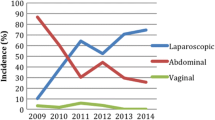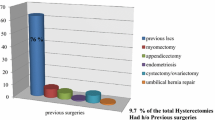Abstract
Purpose
To compare laparoscopic supracervical hysterectomy (LSH) with total laparoscopic hysterectomy (TLH) with regard to relevant surgical parameters and risk factors of conversion to laparotomy and complications.
Methods
This prospective, open, single-center, interventional study included women with benign gynecologic disease who underwent standardized LSH or TLH. The techniques were compared for conversion rate and mean operating time, hemoglobin drop, hospital stay, and complication rates using descriptive statistics and standard non-parametric statistical tests. Risk factors of conversion and complications were identified by logistic regression analysis.
Results
During January 2003 to December 2010, 1,952 women [mean age (SD): 47.5 (7.2) years] underwent LSH [1,658 (84.9 %)] or TLH [294 (15.1 %)], mostly (>70 %) for uterine fibroids. Significant differences in surgical parameters were observed for conversion rate (LSH/TLH: 2.6/6.5 %), mean operating time [87 (34)/103 (36) min], hemoglobin drop [1.3 (0.8)/1.6 (1.0) g/dL], and hospital stay [4.3 (1.5)/4.9 (2.8) days]. Overall intraoperative (0.2/0.7 %) and long-term (>6 weeks) post-operative (0.8/1.7 %) complication rates did not differ significantly, but the short-term LSH complication rate was significantly lower (0.6 vs. 4.8 %). Spotting (LSH, 0.2 %) and vaginal cuff dehiscence (TLH, 0.7 %) were long-term method-specific complications. Logistic regression showed that uterine weight and extensive adhesiolysis were significant factors for conversion while previous surgery, age, and BMI were not. Major risk factors of short-term complications were age, procedure (LSH/TLH), and extensive adhesions.
Conclusions
Both procedures proved effective and were well tolerated. LSH performed better than TLH regarding most outcome measures. LSH is associated with very low rates of re-operation and spotting.
Similar content being viewed by others
References
Sutton C (2010) Past, present, and future of hysterectomy. J Minim Invasive Gynecol 17(4):421–435. doi:10.1016/j.jmig.2010.03.005
Jenkins TR (2004) Laparoscopic supracervical hysterectomy. Am J Obstet Gynecol 191(6):1875–1884. doi:10.1016/j.ajog.2004.06.096
Mueller A, Renner SP, Haeberle L, Lermann J, Oppelt P, Beckmann MW, Thiel F (2009) Comparison of total laparoscopic hysterectomy (TLH) and laparoscopy-assisted supracervical hysterectomy (LASH) in women with uterine leiomyoma. Eur J Obstet Gynecol Reprod Biol 144(1):76–79. doi:10.1016/j.ejogrb.2009.02.004
Kilkku P, Grönroos M, Hirvonen T, Rauramo L (1983) Supravaginal uterine amputation vs. hysterectomy. Effects on libido and orgasm. Acta Obstet Gynecol Scand 62(2):147–152
Thakar R, Ayers S, Clarkson P, Stanton S, Manyonda I (2002) Outcomes after total versus subtotal abdominal hysterectomy. N Engl J Med 347(17):1318–1325. doi:10.1056/NEJMoa013336
van Evert JS, Smeenk JMJ, Dijkhuizen FPHLJ, de Kruif JH, Kluivers KB (2010) Laparoscopic subtotal hysterectomy versus laparoscopic total hysterectomy: a decade of experience. Gynecol Surg 7(1):9–12. doi:10.1007/s10397-009-0529-8
Boosz A, Lermann J, Mehlhorn G, Loehberg C, Renner SP, Thiel FC, Schrauder M, Beckmann MW, Mueller A (2011) Comparison of re-operation rates and complication rates after total laparoscopic hysterectomy (TLH) and laparoscopy-assisted supracervical hysterectomy (LASH). Eur J Obstet Gynecol Reprod Biol 158(2):269–273. doi:10.1016/j.ejogrb.2011.04.021
Wallwiener D, Jonat W, Kreienberg R, Friese K, Diedrich K, Beckmann MW, Hirsch HA, Käser O, Ikle FA (2008) Atlas der gynäkologischen Operationen. Thieme, Stuttgart
Brucker S, Solomayer E, Zubke W, Sawalhe S, Wattiez A, Wallwiener D (2007) A newly developed morcellator creates a new dimension in minimally invasive surgery. J Minim Invasive Gynecol 14(2):233–239. doi:10.1016/j.jmig.2006.10.004
Greenberg JA (2010) Brucker/Messroghli Supraloop™ Unipolar Loop. Rev Obstet Gynecol 3(2):76–77
Bojahr B, Tchartchian G, Ohlinger R (2009) Laparoscopic supracervical hysterectomy: a retrospective analysis of 1,000 cases. JSLS 13(2):129–134
Bojahr B, Raatz D, Schonleber G, Abri C, Ohlinger R (2006) Perioperative complication rate in 1,706 patients after a standardized laparoscopic supracervical hysterectomy technique. J Minim Invasive Gynecol 13(3):183–189. doi:10.1016/j.jmig.2006.01.010
Grosse-Drieling D, Schlutius JC, Altgassen C, Kelling K, Theben J (2012) Laparoscopic supracervical hysterectomy (LASH), a retrospective study of 1,584 cases regarding intra- and perioperative complications. Arch Gynecol Obstet 285(5):1391–1396. doi:10.1007/s00404-011-2170-9
Hobson DT, Imudia AN, Al-Safi ZA, Shade G, Kruger M, Diamond MP, Awonuga AO (2012) Comparative analysis of different laparoscopic hysterectomy procedures. Arch Gynecol Obstet 285(5):1353–1361. doi:10.1007/s00404-011-2140-2
Wallenstein MR, Ananth CV, Kim JH, Burke WM, Hershman DL, Lewin SN, Neugut AI, Lu YS, Herzog TJ, Wright JD (2012) Effect of surgical volume on outcomes for laparoscopic hysterectomy for benign indications. Obstet Gynecol 119(4):709–716. doi:10.1097/AOG.0b013e318248f7a8
Wattiez A, Soriano D, Cohen SB, Nervo P, Canis M, Botchorishvili R, Mage G, Pouly JL, Mille P, Bruhat MA (2002) The learning curve of total laparoscopic hysterectomy: comparative analysis of 1,647 cases. J Am Assoc Gynecol Laparosc 9(3):339–345
Tunitsky E, Citil A, Ayaz R, Esin S, Knee A, Harmanli O (2010) Does surgical volume influence short-term outcomes of laparoscopic hysterectomy? Am J Obstet Gynecol 203(1):24 e21–24 e26. doi:10.1016/j.ajog.2010.01.070
Twijnstra AR, Blikkendaal MD, van Zwet EW, van Kesteren PJ, de Kroon CD, Jansen FW (2012) Predictors of successful surgical outcome in laparoscopic hysterectomy. Obstet Gynecol 119(4):700–708. doi:10.1097/AOG.0b013e31824b1966
Payne TN, Dauterive FR (2008) A comparison of total laparoscopic hysterectomy to robotically assisted hysterectomy: surgical outcomes in a community practice. J Minim Invasive Gynecol 15(3):286–291. doi:10.1016/j.jmig.2008.01.008
Ghomi A, Cohen SL, Chavan N, Gunderson C, Einarsson J (2011) Laparoscopic-assisted vaginal hysterectomy vs laparoscopic supracervical hysterectomy for treatment of non prolapsed uterus. J Minim Invasive Gynecol 18(2):205–210. doi:10.1016/j.jmig.2010.12.005
Warren L, Ladapo JA, Borah BJ, Gunnarsson CL (2009) Open abdominal versus laparoscopic and vaginal hysterectomy: analysis of a large United States payer measuring quality and cost of care. J Minim Invasive Gynecol 16(5):581–588. doi:10.1016/j.jmig.2009.06.018
Lassen PD, Moeller-Larsen H, DEN P (2012) Same-day discharge after laparoscopic hysterectomy. Acta Obstet Gynecol Scand 91(11):1339–1341. doi:10.1111/j.1600-0412.2012.01535.x
InEK GmbH (2012) Fallpauschalen-Katalog 2012. InEK GmbH. http://www.g-drg.de/cms/G-DRG-System_2012/Fallpauschalen-Katalog/Fallpauschalen-Katalog_2012. Accessed 18 Sept 2012
Mueller A, Boosz A, Koch M, Jud S, Faschingbauer F, Schrauder M, Löhberg C, Mehlhorn G, Renner SP, Lux MP, Beckmann MW, Thiel FC (2011) The Hohl instrument for optimizing total laparoscopic hysterectomy: results of more than 500 procedures in a university training center. Arch Gynecol Obstet 285(1):123–127. doi:10.1007/s00404-011-1905-y
Donnez O, Jadoul P, Squifflet J, Donnez J (2009) A series of 3,90 laparoscopic hysterectomies for benign disease from 1990 to 2006: evaluation of complications compared with vaginal and abdominal procedures. BJOG 116(4):492–500. doi:10.1111/j.1471-0528.2008.01966.x
Malzoni M, Perniola G, Perniola F, Imperato F (2004) Optimizing the total laparoscopic hysterectomy procedure for benign uterine pathology. J Am Assoc Gynecol Laparosc 11(2):211–218
McCartney AJ, Obermair A (2004) Total laparoscopic hysterectomy with a transvaginal tube. J Am Assoc Gynecol Laparosc 11(1):79–82
Iaco PD, Ceccaroni M, Alboni C, Roset B, Sansovini M, D’Alessandro L, Pignotti E, Aloysio DD (2006) Transvaginal evisceration after hysterectomy: is vaginal cuff closure associated with a reduced risk? Eur J Obstet Gynecol Reprod Biol 125(1):134–138. doi:10.1016/j.ejogrb.2005.08.009
Jeung IC, Baek JM, Park EK, Lee HN, Kim CJ, Park TC, Lee YS (2010) A prospective comparison of vaginal stump suturing techniques during total laparoscopic hysterectomy. Arch Gynecol Obstet 282(6):631–638. doi:10.1007/s00404-009-1300-0
Lieng M, Lomo AB, Qvigstad E (2010) Long-term outcomes following laparoscopic and abdominal supracervical hysterectomies. Obstet Gynecol Int 2010:989127. doi:10.1155/2010/989127
Lethaby A, Ivanova V, Johnson NP (2006) Total versus subtotal hysterectomy for benign gynaecological conditions. Cochrane Database Syst Rev (2):CD004993. doi:10.1002/14651858.CD004993.pub2
Acknowledgments
The authors thank Sandra Ebersoll, Christian W. Wallwiener, and Adam Kasperkowiak for excellent technical assistance. No financial support or funding was received for this study.
Conflict of interest
All authors were employees of their respective university hospital. SYB was actively involved in the development of the SupraLoop™ unipolar loop for LSH. None of the authors have any financial relationships with instrument or equipment manufacturers or other commercial interests that might represent potential conflicts of interest regarding this work.
Author information
Authors and Affiliations
Corresponding author
Rights and permissions
About this article
Cite this article
Wallwiener, M., Taran, FA., Rothmund, R. et al. Laparoscopic supracervical hysterectomy (LSH) versus total laparoscopic hysterectomy (TLH): an implementation study in 1,952 patients with an analysis of risk factors for conversion to laparotomy and complications, and of procedure-specific re-operations. Arch Gynecol Obstet 288, 1329–1339 (2013). https://doi.org/10.1007/s00404-013-2921-x
Received:
Accepted:
Published:
Issue Date:
DOI: https://doi.org/10.1007/s00404-013-2921-x




